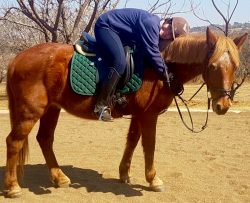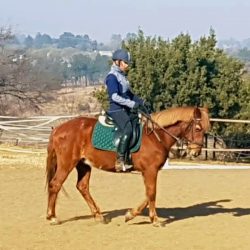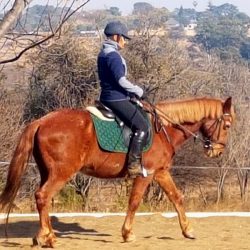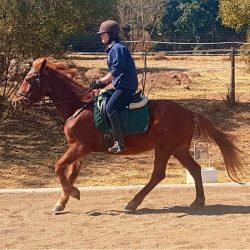Meet 30-year-old Chester, who I occasionally kept in work for Monika.
Now you must understand that l always have to try to make a horse go in a better manner, so l worked on slowing this sprightly young-old pony right down and asked him to go over the back to the bridle and stay balanced.
Simple. It all worked well for short, regular rides and Chester enjoyed going back to his mates in the paddock feeling well. Shame you may say. This poor little pony is 30 years old and l made him work over the back! Is that necessary at his age? Poor little guy! Well, no, it is not necessary, however, it is the kindest thing l could do for him and the best care l could give to an aging pony.

Monika and Chester
Why? ? ?
Again, simple. You see Chester, like all horses/ponies (and people) has grown and aged asymmetrically. He is like a Lays potato chip. His body leans into the right shoulder and is supported mainly by his left fore and right hind. He has become more asymmetrical with age and his neck tilts over towards his heavy mane which falls right. To counterbalance that, his left cheek juts out and the right cheek is tucked in. His body leans over his right shoulder and a million little muscles must contract to hold himself up rather than his relaxed body being softly supported by a firm, balanced skeletal system with hammocks and strings of tendon and ligament to meld it together. He is rather like all of us as we age unless we do something about it!
So, what did l really do?

Chester finding correct posture in the walk

Chester finding correct posture in the trot
l corrected where the nuchal ligament lies. This ligament lies on top of the neck and runs down the spine to become the supraspinous ligament. Basically, it connects to the head and goes all the way to the hindquarters. On Chester, the nuchal part of the ligament lies over to the right side of his neck. l had to first loosen that ligament and make it shift to the top of the neck and then even to the left of the neck. Ultimately this would act like a huge pulley to lift and realign his entire body so that all his parts would fall into a soft, balanced stance. No tension but all poise.
The rider is the horses primary physiotherapist. That is why old, loved horses and ponies are best kept in proper work.
Furthermore, l learned from Chester, a finer ability to realign a horse from the saddle. In studying how to assist him l developed a clearer understanding of how to assist the next horse l rode, and ultimately how to more effectively coach that horses rider.

Monika and Chester enjoying a day of fun!
